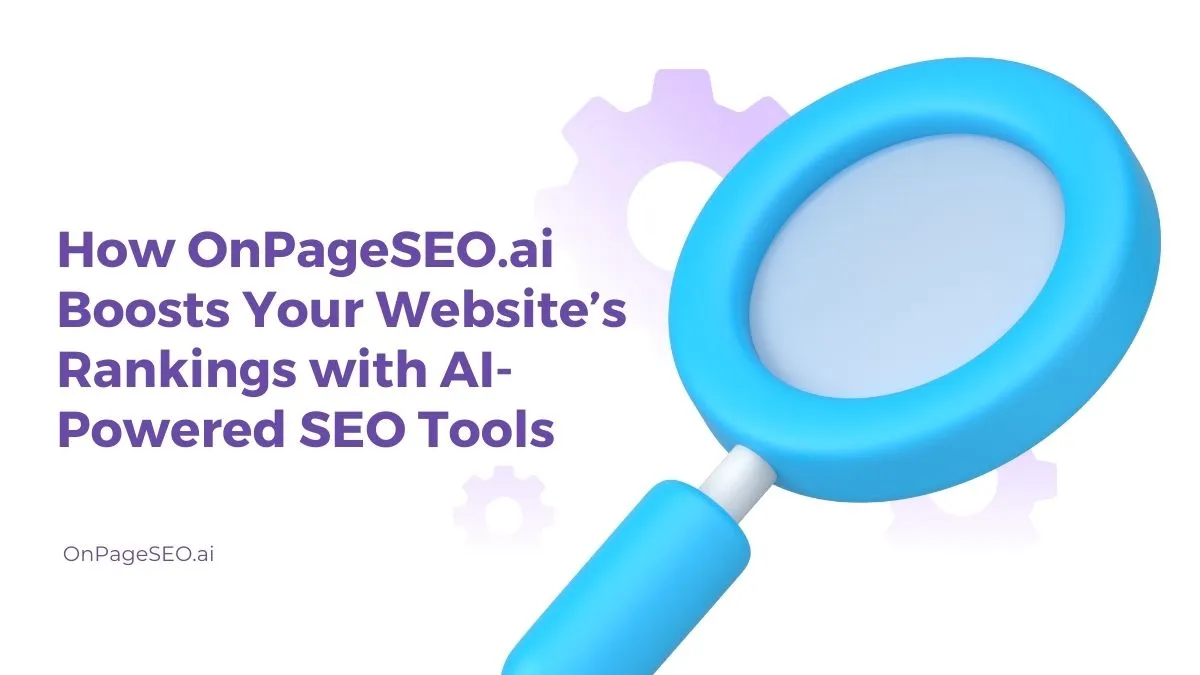AI
How OnPageSEO.ai Boosts Your Website’s Rankings

In today’s digital landscape, achieving high search engine rankings is paramount for online visibility and success. On-page SEO plays a crucial role in this endeavor, ensuring that each webpage is optimized for both search engines and users. OnPageSEO.ai emerges as a powerful ally in this process, offering AI-driven tools that streamline and enhance on-page SEO efforts. This article delves into how OnPageSEO.ai can elevate your website’s rankings through its innovative features and user-centric design.
What is OnPageSEO.ai?
A free Chrome extension titled OnPageSEO.ai comes from Houston IT Developers for on-page SEO optimization simplification. The platform uses artificial intelligence to analyze and recommend SEO strategies at every moment, so users of all skill levels can use it easily. The tool has gained recognition from Google and the NVIDIA Inception Program, which demonstrates its effectiveness and credibility.
Key Features of OnPageSEO.ai
- Instant On-Page SEO Audit: With a single click, users receive a comprehensive health score of their webpage, accompanied by AI-generated suggestions for improvement.
- Header Structure Analysis: The tool visualizes all headers (H1-H6) in a structured format, facilitating better content organization and hierarchy.
- Link Management: OnPageSEO.ai analyzes internal and external links, providing insights into anchor text usage and link distribution to optimize linking strategies.
- Image Optimization: It identifies images lacking alt text, offers file format information, and enables conversion to WebP format for improved loading times.
- Keyword Analysis: The extension tracks keyword distribution and density, assisting in content optimization for targeted search terms.
- Meta Tag and Header Optimization: Users receive AI-generated suggestions for titles and meta descriptions, ensuring alignment with SEO best practices.
- Google Search Console Integration: By integrating with Google Search Console, OnPageSEO.ai offers insights into keyword performance and page metrics.
AI-Powered Optimization Tools
Artificial intelligence at OnPageSEO.ai generates instant data-supported recommendations to optimize on-page SEO functions in real time. The system evaluates webpage components through AI analysis to determine which elements must be enhanced. The system provides users with immediate guidelines that help them optimize their website SEO performance through well-informed decision-making. This method decreases time consumption while guaranteeing that optimization work matches present SEO best practices.
User Experience and Interface
OnPageSEO.ai was built with an interface that focuses on both simplicity and operational efficiency. Installation of this lightweight extension creates immediate access to its features because it does not demand any user login. The software interface displays its information by using color-coded suggestions to identify specific areas that require attention. Interactivity features within OnPageSEO.ai, such as clickable headers combined with link analysis, help users navigate the platform easily for optimization purposes. The design focuses on users, whether beginners or advanced SEO practitioners, who can efficiently work with the tool.

Benefits for Different User Groups
- SEO Professionals: OnPageSEO.ai streamlines the optimization process, providing comprehensive analysis tools that enhance workflow efficiency.
- Content Creators and Bloggers: The tool aids in enhancing content structure and SEO elements, improving visibility and engagement. (
- E-commerce Site Owners: By optimizing product pages, OnPageSEO.ai helps improve search engine rankings, driving traffic and conversions. )
- Digital Marketing Agencies: Managing multiple client websites becomes more manageable with consistent SEO practices facilitated by the extension.
Pricing Plans
OnPageSEO.ai offers two pricing tiers to cater to different user needs:
- Hobby (Free): This plan includes basic features such as on-page SEO analysis, title and meta description checks, link analysis, and header structure audits.
- Pro ($19.99/month): The Pro plan provides advanced features, including unlimited AI-generated titles and meta descriptions, comprehensive Google Search Console insights, and access to all upcoming features and updates.
Integration with Google Search Console
The integration of Google Search Console within OnPageSEO.ai allows users to receive real-time, detailed data that enhances the tool’s performance. OnPageSEO.ai leverages Google’s analytics system to retrieve current performance and keyword position data and page health metrics for users. The system’s frictionless linkage enables users to spot particular SEO problems with their pages by showing them their ranking positions and content performance data. The tool applies automated solutions through its live data capabilities to handle critical problems promptly. The integrated platform enables users to generate more accurate data-based choices, which optimize their site for improved SEO results and superior search rankings.
Image SEO Optimization
The image SEO optimization features in OnPageSEO.ai help optimize page load times and user experience. Users need to improve both accessibility and search engine indexing because the tool uncovers images with no alt text, which are vital for SEO. The tool gives important information about image file formats, along with recommendations about optimized choices that improve loading speed. Users benefit from the optimization process that changes image formats to WebP because this compression method delivers superior file reduction without any quality degradation. Faster image loading speeds become possible through this optimization method because it boosts page speed ranking factors, thus leading to better user engagement and retention.
Link Management and Analysis
Effective link management is a crucial aspect of on-page SEO, and OnPageSEO.ai excels in this area by providing comprehensive link analysis. The tool evaluates both internal and external links, offering valuable insights into their distribution, anchor text usage, and overall impact on a website’s SEO. It identifies problematic links, such as broken or low-quality external links, and provides suggestions to enhance internal link structures. Additionally, OnPageSEO.ai uses color-coded indicators to make it easier for users to spot and fix any link-related issues. This detailed analysis helps optimize link strategies, improving a website’s crawlability, user navigation, and overall SEO performance, which is crucial for ranking higher in search engine results.
Conclusion
The AI-powered solution OnPageSEO.ai presents a complete tool that simplifies the tasks necessary for on-page SEO optimization. Through its intuitive platform and immediate assessment tools, and practical guidance, OnPageSEO.ai functions as an essential tool for boosting website search engine rankings. Users obtain enhanced online presence through OnPageSEO.ai since it provides tools that handle essential SEO elements such as metadata alongside content structure and link management. OnPageSEO.ai operation will boost visibility and performance for all SEO professionals, content creators business owners who integrate this tool into their optimization plans.
-

 BIOGRAPHY6 months ago
BIOGRAPHY6 months agoBehind the Scenes with Sandra Orlow: An Exclusive Interview
-

 HOME1 year ago
HOME1 year agoDiscovering Insights: A Deep Dive into the //vital-mag.net blog
-

 HOME1 year ago
HOME1 year agoSifangds in Action: Real-Life Applications and Success Stories
-

 BIOGRAPHY1 year ago
BIOGRAPHY1 year agoThe Woman Behind the Comedian: Meet Andrew Santino Wife




























